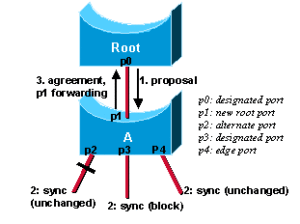
Whether you are pursuing your CCNA, CCNP, CCIE, or many other Cisco Certifications, a deep knowledge of RSTP is critical. In this post, we will detail key facts for you regarding this Layer 2 loop prevention system.
- 802.1w (RSTP) is an evolution of the classic 802.1D (STP) protocol
- 802.1D tried to speed things up with the additions of UplinkFast, BackboneFast, and PortFast; the UplinkFast and BackboneFast features are now essentially built into RSTP, while PortFast is still a feature you enable in RSTP if desired
- 802.1w can also revert back to 802.1D in order to interoperate with legacy bridges on a per-port basis
- With 802.1D, once in the forwarding state, there is no way to tell from the port state whether the port is root or designated; RSTP decouples the role and the state of a port to address this issue
- The 802.1D port states are Disabled, Blocking, Listening, Learning, Forwarding; in 802.1w these are simplified to Discarding, Learning, Forwarding
- The port roles are expanded in 802.1w to include Backup and Alternate ports in addition to Root and Designated; these new port roles help implement the features of UplinkFast into the protocol natively
- A Backup port receives more useful BPDUs from the same bridge it is on and is a port blocked
- An Alternate port receives more useful BPDUs from another bridge and is a port blocked
- RSTP now uses all six bits of the flag byte that remain in order to perform – encoding the role and state of the port that originates the BPDU and handling the proposal/agreement mechanism
- The RSTP BPDU is now of type 2, version 2; legacy bridges must drop this new BPDU; this makes it easy for an 802.1w bridge to detect legacy bridges connected to it
- BPDUs are sent every hello-time, and not simply relayed anymore’
- BPDUs are now used as a keep-alive mechanism between bridges; a bridge considers that it loses connectivity to its direct neighbor root or designated bridge if it misses three BPDUs in a row; this fast aging of the information allows quick failure detection
- To natively support the BackboneFast type behavior, RSTP accepts inferior BPDUs; when a bridge receives inferior information from its designated or root bridge, it immediately accepts it and replaces the one previously stored; this permits fast acceptance of a new Root port in the topology
- Rapid transition is the most important feature introduced by 802.1w; RSTP is able to actively confirm that a port can safely transition to the forwarding state without having to rely on any timer configuration; in order to achieve fast convergence on a port, the protocol relies upon two new variables: edge ports and link type
- RSTP can only achieve a rapid transition to the forwarding state on edge ports and on point-to-point links; the link type is automatically derived from the duplex mode of a port
- A proposal/agreement process in RSTP aids in very convergence
- The topology change notification process is overhauled in order to also aid in faster convergence and improve efficiency
For more details on these new features summarized here – check out Understanding Rapid Spanning Tree Protocol (802.1w) This document often forms the basis for plenty of RSTP-related written exam questions from CCENT to CCIE. Note that my summary document here covers most of those questions for you, however!
